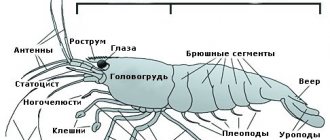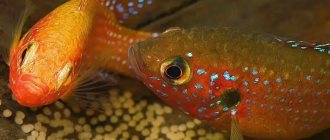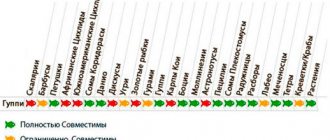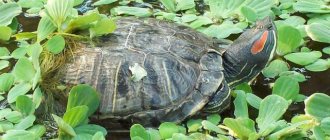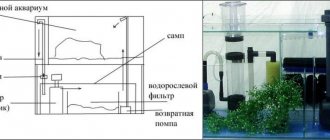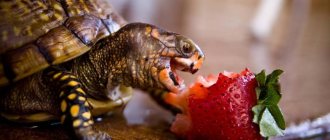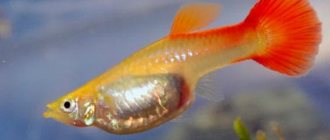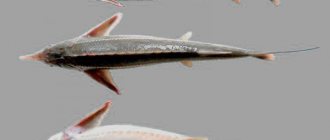Sturgeon is an excellent source of tasty and nutritious meat, valuable black caviar and leather. Therefore, it is profitable to breed this fish at home. But growing “royal fish” will be successful and profitable only if you know how to properly maintain it - sturgeon is capricious and requires special conditions.
Why breed sturgeon?
- Many people grow this fish as a hobby or for their own consumption. However, sturgeon is also suitable for building a business around its cultivation. Income can be received from the sale of:
- caviar;
- live individuals, chilled or frozen carcasses;
- dried or smoked product;
- soup set (fins, heads, tails, bellies);
- liver;
- glue used to restore various products and apply gilding;
- fry
The most valuable of the products described is caviar. The price for 30 g starts from 450 UAH, 100 g - 1700 UAH. Wholesale price - from 500 dollars per kilo. However, to obtain eggs, it is necessary to raise females until they are 10–14 years old, and males until they are 8–12 years old. It is at this age that representatives of this species of fish undergo puberty. Sturgeon spawn once every 3 years.
If you plan to grow fish for sale fresh or chilled, then individuals reach a weight of 1.2–1.5 kg in 1 year.
Who to sell sturgeon fish to?
You can sell your products according to various schemes: sell on the market, where you can organize your own retail outlet, sell in a store by agreement with the owner, or supply to restaurants by concluding appropriate agreements. Through restaurants you can sell up to 70 kg of sturgeon per month. It is not difficult to calculate how much fish needs to be grown per year: up to 1 ton of fish or up to 2000 units, weighing 0.5 kg each. These small sturgeons are the most sought after in the restaurant business. The most exquisite and delicious dishes are prepared from them.
As practice shows, you can make serious money on a home mini-farm. In about 3-5 years, if you approach it smartly, you can organize a business with a turnover of several million rubles, and this on your own backyard or summer cottage. But not everything can be obtained immediately and instantly. In any case, you should start with a small volume of growing sturgeon meat. And when experience and confidence appear, production volumes can be increased, not immediately, but also gradually: first raise 1000 fry, then, if possible, 2000 pieces, and then, as they say, appetite comes with eating.
Breeding methods
Sturgeon can be bred at home in 5 ways:
- In a natural body of water. For breeding, you will need a small pond, which is pre-cleaned. Plants are placed in it, snails and worms are released. Sturgeon fry are released in the spring. The main advantage of this method is low costs and no need for additional equipment. The main disadvantage is keeping sturgeon in winter, since the water must be prevented from freezing.
- In an artificial pond. For breeding, you will need to dig a pool 2 m deep and 200 m² in area. The water in it will need to be constantly filtered and saturated with oxygen.
- In a plastic pool. The optimal depth of such a container should be at least 1 m, for fry - 70 cm. If the area of one room allows, several containers can be installed in it. Swimming pools must be connected to the water supply and sewerage system. Lighting needs to be installed in the room.
- In the cages. This is one of the most convenient ways of breeding fish. Net cages are placed in a lake or river and the sturgeons are fed artificial food. The convenience is that there is no need to clean the cages, since all contaminants are naturally washed away with water.
- In a closed water supply installation (RAS). This is the most expensive method, since it is necessary to purchase special equipment, which includes daily topping and purification of water, sterilization, temperature stabilization, and O₃ saturation. The advantages of the method are that while maintaining constant conditions favorable for sturgeon, the fish grows quickly, including in winter. The risk of death is reduced to a minimum.
Necessary equipment
For the full cultivation and reproduction of sturgeon fish, certain equipment is required. An entrepreneur must purchase the following:
- Pump. If fish are raised in the private sector, then a pump will be needed to supply water from a well or well.
- A compressor that constantly saturates the water with oxygen. It is recommended to install several such installations at once, so that if one pump fails, another one is connected to operation.
- Filtration installation. The equipment purifies contaminated water and allows it to be reused without harming the fish.
- Heat exchangers and heaters. These elements are necessary to maintain the required temperature. In the summer they cool the water, in the autumn-winter they heat it up.
- Diesel or gasoline generator. This element will ensure an uninterrupted supply of oxygen and water to the reservoir even in the absence of power supply. A generator must be present in a sturgeon farm, since one cannot be completely insured against interruptions in the power grid.
After purchasing and installing the necessary equipment, it’s time to purchase sturgeon fry.
When releasing fry into a pond, you need to adhere to the following scheme: for 1 sq. m accounts for at least 60 kg of live sturgeon.
Advantages and disadvantages of keeping sturgeon
The sturgeon business at the initial level does not require large investments. Anyone can start it at their dacha, garage, basement, greenhouse, barn. However, at the first stage it is necessary to calculate all the pros and cons. The advantages of sturgeon breeding include:
little competition;
high profitability;
the popularity of sturgeon in cooking, which means there is a constant demand for it.
Among the disadvantages it is worth mentioning:
- the fish's demands on certain conditions;
- sensitivity of fry and, as a result, their poor survival;
- the need for constant monitoring of fish;
- difficulties in acquiring quality fry.
Sturgeon in their pond
Fish are sensitive creatures, and it is important for them to create a balanced ecosystem. However, other than this, you will not have to put in almost any effort. The fish will grow on its own. The main thing is to create favorable conditions for her to do this. Today, all kinds of fish are bred - salmon, sturgeon, and even delicious silver carp. Let's focus on the luxurious sturgeon fish.
The sturgeon genus includes beluga, sterlet, stellate sturgeon and, in fact, sturgeon. Sturgeon
, as you know, is incredibly expensive when it appears on a store counter, and we’re not even talking about caviar.
After all, black caviar
, the most expensive known, is just sturgeon caviar.
If you have a pond and decide to start breeding sturgeon, think about why you need it? Perhaps solely for personal purposes. After all, you can regularly have fish on your table, tested and healthy, and you can constantly eat the most valuable caviar, for which you would otherwise have to shell out a lot of money. However, you can do it differently. You can fish for your own pleasure, create a fishing “resort”. Make it paid. This is already a business. You can establish connections with shops and restaurants and sell sturgeon meat and caviar profitably. In any case, sturgeon means money and benefits.
Purchase sturgeon fry (it is better to start breeding with fry
, and not from caviar) is better in special farms that already breed sturgeon.
They will tell you all the intricacies of the matter, and will sell already proven fry, which are not as shy and wild as those that grow in natural conditions. Of course, quality housing must be prepared for the arrival of settlers. It is not enough to simply pour them into an existing pond. First, it needs to be cleaned. If the pond
is artificial, then liming is carried out 2 weeks before the fish appear. To do this, sprinkle the bottom with lime and fill it with a small amount of water. Then rinse.
In addition, the pond must have basic flora and fauna - some kind of algae, reeds. Among small organisms, mollusks
, daphnia, worms. Why is this necessary? Firstly, this is food. Secondly, they are scavengers. Such residents help maintain cleanliness in the pond and a constant microclimate that is optimal for sturgeon. Insects that fall into the pond will also be useful - fish eat them with pleasure.
Of course, this does not mean that this is enough nutrition. When you bring in the fry, at first they will not be particularly demanding of food. By the way, fry must be transported to the pond in the summer, and at night. It is not so hot at this time; sturgeon are afraid of the heat. So, for the first month the fry will subsist on natural food. However, when they begin to enter adulthood, in order to gain weight they need to be given ready-made food, already balanced. They can be bought in specialized stores. There are quite enough microelements and nutrients necessary for fish.
When the fish reach sexual maturity, they must be placed in a special spawning pond created artificially. It is very small, the depth is no more than half a meter. Then the male is taken from there, the eggs (or already hatched fry) are collected and moved back to the reservoir. Care must be taken not to introduce an infection with the male, which could destroy the offspring.
Sturgeon meat and caviar are incredibly healthy, but you need to be very vigilant so that the fish does not first infect itself, and then you.
Source
Sturgeon breeds suitable for breeding at home
Sturgeons are large fish with an elongated body that can reach a maximum length of 6 m. On average, they grow up to 3 m. The largest individual that was caught weighed 816 kg. In the wild, sturgeons live in seas and rivers. They lead a bottom lifestyle.
The genus Sturgeon has 17 species. Most of them are best suited for breeding at home. We suggest that you familiarize yourself with a brief description of some varieties.
Siberian. Differs in slow growth. Lives up to 60 years. The natural habitat is Siberian rivers: Ob, Kolyma, Irtysh, Yenisei, lakes Baikal and Zaisan. The body length of the fish is 2 m. Mature individuals weigh 200 kg. Sexual maturity in females in the wild occurs at 11–18 years, in males at 9–18 years. Spawning occurs once every 3–4 years.
White. This species is found off the west coast of North America. Its representatives are the largest freshwater fish in this region and the third largest in the Sturgeon family, after beluga and kaluga. They reach a fishing weight of 15–20 kg and a length of 6 m.
Russian. This species is endemic to the Ponto-Caspian basin. The fish is found in the Black, Caspian and Azov seas. Spawns in rivers. The body length of representatives of the species is 1.1–2.3 m, weight is up to 100 kg (industrial – 15–16 kg). Males become sexually mature at 8–10 years, females at 10–14 years. Fertility under natural conditions is 250–350 thousand eggs. There are hybrids of the Russian species with sterlet, beluga and thorn.
Amur (Japanese). A fish that grows in natural conditions up to 2.5 m in length and reaches a weight of 56 kg. Lives up to 65 years. As the name implies, representatives of the species live in the Amur, Amur Estuary . A separate population is represented off the coast of Japan. Puberty for males occurs at 9–10 years, for females at 11–14 years. Fecundity is 29–434 thousand eggs.
Atlantic . The species is distributed off the coast of North America and in the Baltic Sea. In nature it grows up to 6 m and can gain up to 400 kg. Males are able to mate upon reaching 7–9 years of age, females at 10–14 years of age.
Ozerny . A freshwater species found off the North American coast. Leads a bottom lifestyle. The fish grows up to 2 m and weighs up to 100 kg. Lives up to 100 years. Male individuals of the lake species reach sexual maturity at 7–8 years, females at 10–13 years.
Persian. Representatives of the species are similar in appearance to Russian sturgeons. They differ from it in their elongated, massive, curved snout and lighter color. The fish are found in the Caspian and Black Seas. Individuals grow up to 2.4 m, 80 kg.
Sterlet. Representatives of the species live in fresh waters, mainly at the bottom. They have a small body length - 35–55 cm. They reach a maximum weight of 5–6 kg. Puberty of this sturgeon occurs at an early stage: in males - at 4-6 years, in females - at 10-14 years. During spawning, females lay 10–70 thousand eggs.
Stellate sturgeon. The fish is common in the Caspian, Black and Azov seas. Its body length is 2.2 m, weight - up to 80 kg. Puberty in males occurs at 5–13 years, in females at 10–17 years. Fertility is 35–630 thousand eggs.
Thorn. A bottom-dwelling fish with a body length of 2 m and a weight of 80 kg, living in the Black, Azov, Caspian and Aral seas. It goes into rivers to spawn. Lives up to 30 years. Thorn girls reach sexual maturity at 12–14 years, boys at 6–9 years. The fertility of females is 200 thousand–1 million eggs.
Choosing the right farm premises
Provided that everything is done correctly, breeding can be carried out not only in a country house, but even in an apartment, if, of course, its size allows it. This will not affect the quality in any way, so there is no need to worry about it. To accommodate all the necessary equipment, you will need about 30 square meters of space.
The room must be heated, because for constant growth of sturgeon, a temperature of at least 17 degrees is required. At this temperature, the fish will grow even in winter, which it does not do outdoors under normal natural conditions. In summer, the water should be between 20–24 degrees.
It may happen that the required premises are not available. Then, as an option, you can install a polycarbonate greenhouse in which a swimming pool, boiler and everything else will be installed, which we will talk about later.
Features of purchasing and launching fry
A novice sturgeon breeder should first take care of purchasing fry. This can be done in fish farms and factories. Before purchasing, it is advisable to visit the point of sale yourself and see with your own eyes the conditions in which the fish are grown, and also agree on delivery methods. The weight of fish purchased for breeding ranges from 3 to 5 g.
The pricing policy for sturgeon fry in Ukraine is as follows:
- Lensky sturgeon - 4–8 UAH/piece;
- sterlet - 8.1–8.6 UAH/piece;
- bester - 12 UAH.
Zarybok weighing 400–900 g costs from 250 UAH. per kilo.
To calculate how many fry you need to purchase, you should know that for beginners their mortality rate is about 40–50%. In order to assess your strength and understand how profitable breeding is, you can first purchase 500 fry.
Before you put fish into a pond, you need to create certain conditions for them. It is necessary to pour water from the transport tank into the water in the pool so that it becomes almost the same temperature and is comfortable for the fry. Over the next 3 days, the water temperature should be gradually brought to +19...+22°C. The oxygen level should be set to 8 g/m².
In the first 2 days, the fry are not given food, and the lighting is extended to 19 hours a day. From the third day, an eight-time feeding regimen with starter feed and live feed is established.
After 2 weeks of keeping the fry, they are transferred to six meals a day. Daylight hours are reduced by 1 hour.
Every 14 days it is necessary to inspect the fry and place them in different containers according to body size. Otherwise, large individuals will constantly take food from small ones.
Optimal water parameters for successful fry rearing:
- the maximum permissible temperature difference is 3–5°C;
- transparency level - 1.4–1.6 m;
- oxygen level - 8–15 g/m³;
- carbon dioxide level - 8–10 g/m³;
- suspended solids content - 20–25 g/m³.
Normally there should be 0.3–0.5 g/m³ ammonium, 0.01–0.02 g/m³ nitrites, 0.8–1 g/m³ nitrates, 0.2–0.3 g/m³ phosphates, 0.3–0.5 g/m³ iron.
Business Features
Of course, many novice entrepreneurs have an idea of the basic rules of fish farming. But growing sturgeon differs significantly from breeding carp in a pond - primarily in the matter of providing optimal conditions for rapid weight gain. In addition, this business has other features:
- Sturgeon is a premium product. Its cost is comparable to the prices of salmon meat. As for caviar, it is ten times more expensive than analogues of other types;
- There are not many sturgeon breeding farms in Russia. Therefore, an entrepreneur, within reasonable limits, can pursue his own pricing policy;
- Sturgeons feel quite comfortable in captivity. Moreover, when kept in artificial conditions, their productivity even increases;
- You don't need to be an expert to master the technology of growing sturgeon. Currently, this topic is covered in detail in scientific works and articles;
- If you provide the fish with a balanced composition of feed, good water quality and the correct stocking density, then it will practically not get sick;
- Sturgeon breeding as a business remains in demand regardless of the influence of political or economic factors.
Conditions for keeping adult fish
In principle, keeping sturgeon is not difficult. The main thing is to know how to care for it, maintain comfortable conditions and what to feed it.
The water must be clean - constantly filtered and saturated with oxygen. Remains of food, garbage, and dead fish must be removed immediately. Otherwise, the sturgeon will begin to get sick and die.
Water should be changed by 15% every 3 days. If it comes from the water supply, it should be filtered using a carbon filter.
The pool must not be overcrowded. The recommended population density is 50–55 kg of live fish weight per 1 m² of bottom area.
Requirements for water temperature: in summer - +19...+25°C, in winter - +12...+15°C. Water composition indicators must meet the following standards:
- pH - 7–8.5;
- O₃ - 7–12 g/m³;
- CO₂ - 18–20 g/m³;
- P - 0.3–0.5 g/m³;
- Fe - 1–2 g/m³;
- nitrates - 6.7–7.3 g/m³;
- nitrites - 0.1–0.2 g/m³;
- NH₃ - 0.03–0.05 g/m³;
- NH₄+ - 2–5 g/m³;
- suspended substances - 25–30 g/m³.
Possible problems and their solutions
When breeding sturgeon, you may encounter a number of difficulties. The death of fry is one of the common problems, usually caused by:
- water pollution;
- poor quality food;
- reduced water temperature.
Let's celebrate! Regular cleaning of reservoirs, changing water, properly selected high-quality food, purchasing generators that will help out if there is a power failure will help reduce the mortality rate of young fish.
Rules for feeding sturgeon
Specialized stores sell special food for sturgeon of different ages. It is nutritious and contains all the necessary elements. The main requirements for it: an attractive smell for fish, rapid sinking to the bottom, dissolution within half an hour.
You can also prepare the mixture yourself from the following components:
- fishmeal (42%);
- soybean meal (24.97%);
- corn gluten (15%);
- corn germ (5%);
- probiotic (0.03%);
- sunflower liquor (5%).
Other options for composing mixtures are also possible.
Adult sturgeons are fed 4 times a day, always at the same time. If food does not reach the fish on time, they experience stress, which negatively affects their development, health and weight gain.
To determine how much food sturgeon need, you should focus on live weight. For example, at the age of 30–40 days and weighing 2–4 g, fry need 6.4–6.9% of feed of their body weight, 200-day-old individuals, 100–500 g each, need 1.8–2.3%, yearlings 2-3 kg fish - 0.7-1%. If the sturgeon has reached more than 3 kg, then 0.5–0.7% will be enough for him.
How to feed fish correctly
To quickly grow fish, you need to give it balanced food, which is intended for sterlet. The main characteristics of food for sterlet are as follows:
- It should have an attractive smell for sterlet.
- It's easy to drown in water.
- Do not dissolve in water for 30 minutes.
You can either purchase food for sterlet in the store or cook it yourself. The main thing is to check the content of microelements and vitamins in food. In addition, you need to choose the size of the food granules, especially for young fish.
What is needed to organize a sturgeon farm with RAS
To install 8 swimming pools with a diameter of 2.5 m with RAS, you will need a room with a minimum size of 6x12 m. It must be equipped with heating, lighting, water supply, water drainage systems (sewerage, storm drains, septic tank), and ventilation. You should expect that your daily water consumption will be about 5–6 m³. To prevent stress in fish and slow weight gain, it is advisable that the room is located in a quiet area.
The RAS can be assembled independently from parts purchased at retail or purchased ready-made. The cost of a mini-installation for beginners with pools with a volume of 6 m³ starts from 135 thousand UAH.
So, growing sturgeon is not a very difficult and profitable business. To start it, you need to choose an affordable method of keeping, purchase fry, food and maintain the necessary conditions for the life of the fish. The process of raising sturgeon from fry to adults that can be sold takes on average about 1.5 years.
How to register a business
Unfortunately, sturgeon are a favorite prey for poachers. When choosing what can be traded profitably on the market, an entrepreneur must understand: if you do not document the origin of fish or caviar, you may face persecution from both tax and law enforcement agencies. Therefore, it is better to register your farm as an individual entrepreneur or peasant farm. During the registration process, you must indicate the appropriate activity codes:
OKVED sturgeon breeding
| 03.21 | Marine fish farming |
| 03.21.1 | Marine industrial fish farming |
| 03.22 | Freshwater fish farming |
| 03.22.1 | Freshwater industrial fish farming |
Freshwater fish farming as a business is classified as an agricultural activity: such products are mentioned in Decree of the Government of the Russian Federation No. 458 of July 25, 2006 under numbers 03.22.40.150 and 03.22.40.160. Accordingly, a businessman has the right to use the Unified Agricultural Tax system. If we are talking about breeding sturgeon in sea water, then there is no alternative to the simplified tax system.
The farmer also needs to undergo inspection by sanitary and veterinary inspections. To do this, you will have to provide them with water analysis results, certificates for the plastic from which the pools are made, certificates for feed and documents for fry. Based on the results of the inspection, the company will be registered.
In the future, before selling each batch, you need to send water and a couple of kilograms of sturgeon to the veterinary service for analysis. In return, the organization will issue veterinary certificate No. 2 for this batch necessary for sale.
Where to buy fry?
Experienced fish breeders, when growing sterlet and other representatives of the sturgeon order, categorically do not recommend saving on the purchase of fry. The purchase of material for sturgeon breeding should be carried out only from trusted suppliers. It should be taken into account that the survival and growth of fish, and therefore material profit, directly depend on its quality.
It is best to buy fry from large fish farming enterprises. Before purchasing from reliable sources, it is recommended to carefully study the information about the seller. You should not purchase too much material; you need to calculate the number of fry required for growing in specific conditions. The following formulas are used for this:
| Weight of fry, g | Optimal quantity per 1 sq. m capacity |
| 1-3 | 400-500 pcs |
| 3-5 | 300 pcs |
| 5-11 | 50-60 kg |
| 11-18 | 40 kg |
Who should I sell to?
Products are usually sold in large quantities to food outlets, fish stores, and supermarkets. You can sell goods on the market yourself by renting a place. At first, you will have to spend a lot of effort on finding ways to sell, but later, when you acquire regular customers, the problem with sales will disappear. To attract customers, it is recommended to create an informative website. You shouldn’t skimp on its promotion – the investment will definitely pay off later.
Source
